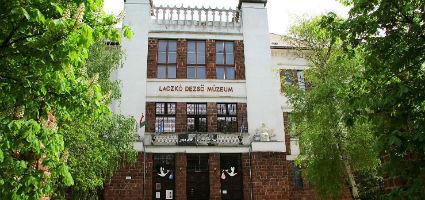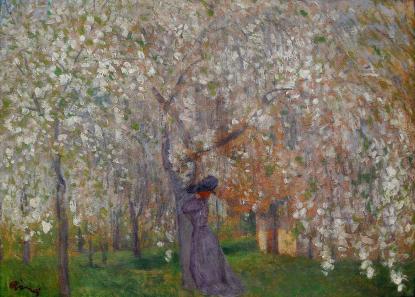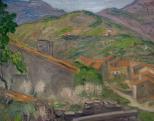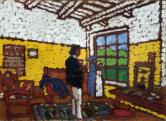2024. April 26. Friday
Dezső Laczkó Museum - Veszprém
 |
Address: 8200, Veszprém Török Ignác u. 7.
Phone number: (88) 789-791
E-mail: titkar@ldm.hu
Opening hours: Thu-Sat 10-18
|
The exhibition has closed for visitors.
2015.11.19. - 2016.02.28.
The exhibition is co-organized by the Rippl-Rónai Museum of Veszprém and the Laczkó Dezső Museum. In November 2015 the two institutes will exchange exhibitions: In Veszprém works of art by József Rippl-Rónai, in those by Kaposvár József Egry will be shown to the public. The objective of the Laczkó Dezső Museum is to present further exchange exhibitions and thus bring exclusive material to Veszprém.

Rippl-Rónai's life and artistic approach is a story to be told in a novel. After graduating as a pharmacist he began studying painting at the Munich Academy. In 1887 he worked in Paris in Mihály Munkácsy's workshop as an assistant. After two years he felt his tutor and began his own journey. As a member of French post-impressionist, group known as the Nabis group he translated the most modern artistic aspirations into hhis own language: from then on his art would increasingly be characterized by boldly stylized lines and decorativity. The ethereal painted portraits of women and brave, compositions reduced to black lines from the time of his stay in Paris are special pieces of Hungarian art.
Rippl-Rónai moved to Kaposvár 1902 where he stayed until his death. The interior series he painted there invited the viewers to have a look inside the life of the citizens of the town. The artist only depicted what he knew well and loved. During the intimate portrayal of the home environment, he embedded the modern Parisian vision into indigenous culture that eventually brought huge acclaim for the artist in 1905.
Already a successful artist, he bought the villa Rome in the suburbs of Kaposvár in 1908. A new pictorial styles with excitingly unique atmosphere, unique in Hungarian painting was born in the villa. Rippl-Rónai went on developing Gauguin's custom decorative colour filling method with his brown contoured brilliant colours. The pictures with corn radiating outbursts of joy of life reflect in a playful manner on the world around the artist. For his contemporaries Rippl-Rónai, the first Hungarian modern painter was a contradictory figure. To those who inquired him about the strange style of his paintings he just answered that he represented a trend already accepted in Paris.
The late artistic era of the painter who was celebrated by the capital's social scene was filled with portraits. He painted a pastel picture of the writers with the 'Nyugat' as well as actors, beautiful ladies, including his muse, Zorka, whose special face he painted multiple times.
The 40 works that are arriving from the Rippl-Rónai Villa in Kaposvár represent the most important artistic eras of the artist. In addition to the colourful corn pictures by Rippl-Rónai, we show several of his spirited character paintings and studies as well. The exhibition illustrates the flourishing of modern civil spirit.

Rippl-Rónai's life and artistic approach is a story to be told in a novel. After graduating as a pharmacist he began studying painting at the Munich Academy. In 1887 he worked in Paris in Mihály Munkácsy's workshop as an assistant. After two years he felt his tutor and began his own journey. As a member of French post-impressionist, group known as the Nabis group he translated the most modern artistic aspirations into hhis own language: from then on his art would increasingly be characterized by boldly stylized lines and decorativity. The ethereal painted portraits of women and brave, compositions reduced to black lines from the time of his stay in Paris are special pieces of Hungarian art.
Rippl-Rónai moved to Kaposvár 1902 where he stayed until his death. The interior series he painted there invited the viewers to have a look inside the life of the citizens of the town. The artist only depicted what he knew well and loved. During the intimate portrayal of the home environment, he embedded the modern Parisian vision into indigenous culture that eventually brought huge acclaim for the artist in 1905.
Already a successful artist, he bought the villa Rome in the suburbs of Kaposvár in 1908. A new pictorial styles with excitingly unique atmosphere, unique in Hungarian painting was born in the villa. Rippl-Rónai went on developing Gauguin's custom decorative colour filling method with his brown contoured brilliant colours. The pictures with corn radiating outbursts of joy of life reflect in a playful manner on the world around the artist. For his contemporaries Rippl-Rónai, the first Hungarian modern painter was a contradictory figure. To those who inquired him about the strange style of his paintings he just answered that he represented a trend already accepted in Paris.
The late artistic era of the painter who was celebrated by the capital's social scene was filled with portraits. He painted a pastel picture of the writers with the 'Nyugat' as well as actors, beautiful ladies, including his muse, Zorka, whose special face he painted multiple times.
The 40 works that are arriving from the Rippl-Rónai Villa in Kaposvár represent the most important artistic eras of the artist. In addition to the colourful corn pictures by Rippl-Rónai, we show several of his spirited character paintings and studies as well. The exhibition illustrates the flourishing of modern civil spirit.




